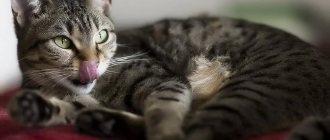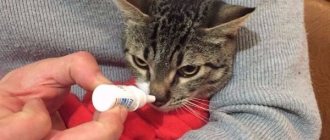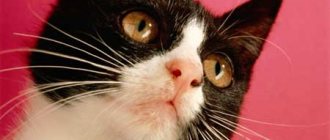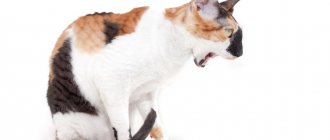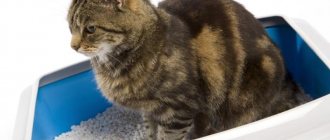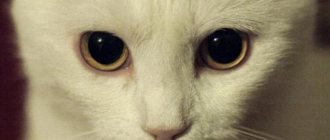Heart disease in an animal is always difficult to predict. Pets are not people; they cannot tell if they are experiencing chest pain. That's why so many mustachioed friends die from heart disease. Heart attacks in cats most often occur suddenly, so it is important for the owner to know what the symptoms and causes of this disease are, as well as how to treat it.
Veterinarians note that myocardial infarction is very rare in felines, but this does not diminish its health hazard. It is caused by the death of a section of the pet's heart muscle. This provokes severe dysfunction in the functioning of a vital organ. Without medical intervention, the animal will soon die.
Causes of a heart attack in a cat
As a rule, such reasons are associated with other diseases in the cat:
- Various congenital heart defects. The main anomalies leading to a heart attack are associated with pathology of the valvular apparatus of the heart.
- Heart rhythm disturbances.
- Genetically determined diseases of the vascular bed.
- Vasculitis is an inflammatory disease of blood vessels. A smaller amount of blood arrives from inflamed vessels to the myocardium. This leads to disruption of the nutrition of cardiomyocytes. Heart muscle cells cannot tolerate prolonged hypoxia. Ischemia of the cardiac muscle tissue occurs quickly.
- As an animal ages, changes in the structure of the myocardium may occur, which can also cause a cat to have a heart attack.
- Infection of a cat with helminths and blockage of blood vessels by them.
- If there was a blood clot somewhere in the pet’s vascular bed, it broke off and blocked the coronary artery - myocardial infarction is inevitable.
- Blockage of the arteries supplying the heart by emboli (an air bubble in the blood or a fat drop) will also lead to the death of myocytes.
- Diseases of the endocrine system (diabetes mellitus, hyperthyroidism) contribute to the occurrence of a heart attack.
- Infectious diseases in cats contribute to heart attacks. Especially if they are chronic.
- Loss of large amounts of blood, leading to severe anemia. In such a situation, myocardial trophism sharply worsens.
- Poisoning with pesticides, heavy metals and FOS also has a detrimental effect on the heart.
- Malnutrition of the cat, due to which plaques are deposited on the vessels.
- Chronic stressful situations.
Attention!
A fat cat with cheeks is a cute sight. But everything should be in moderation. You should not overfeed your cat if you do not want to get serious health problems in the future.
Causes of heart failure
- Congenital heart pathologies. In cats they are quite rare, occurring in approximately 2% of all cases.
- Diseases of the heart muscle caused by infectious diseases.
- Cardiomyopathy, which is caused by an inadequate diet in cats. They, as a rule, do not receive enough taurine, which is part of raw fish and meat. During cooking, it is destroyed.
- Heartworms and their larvae are found in mosquitoes. They are microscopic in size. When a mosquito bites, their larvae enter the animal’s bloodstream and settle in the pulmonary artery. Heartworms can grow up to 30 centimeters in size. With their presence in the circulatory system, they interfere with the outflow of blood and cause enormous damage to the arteries. Adults entangle the heart, thereby interfering with its full functioning. Heartworms can be detected using a blood test.
- Age-related hormonal changes. Heart failure is thought to occur in cats over 6 years of age.
- Metabolic disease. Sometimes it is caused by improperly structured nutrition.
Cats should be periodically screened for heartworms to help prevent heart disease. If a taurine deficiency is noticed in a timely manner, it must be introduced into the cat’s food, due to which the vital activity of the heart muscle is restored.
Diagnosis must be carried out by a qualified veterinary cardiologist in order to prescribe the correct treatment. Typically it includes:
- Blood analysis.
- Analysis of urine.
- Ultrasound.
- Chest X-ray.
- ECG.
If a cat has been diagnosed with heart failure, then it should be excluded from planning for breeding, since the hereditary factor plays an important role.
Symptoms: When should you worry?
Not all cats are prone to coronary heart disease.
Most often, it affects cats that lead a sedentary lifestyle and love to eat a lot. Therefore, even if the cat lives in an apartment with little space, you need to play with it a lot so that it develops physically. Forays outside will also be useful.
You also shouldn't keep your cat stressed all the time. Animals really don’t like changing homes or owners. For them, just like for people, losing a loved one or furry friend is scary.
Care and nutrition
After returning home, the animal should rest more time and move less.
The success of therapy depends not only on the recommendations of the veterinarian and prescribed medications, but also on the owner who will care for the pet at home. After the heart attack has been suffered, the cat will need to create conditions of complete rest. The animal is sent to a quiet and dark room where it will not be disturbed by other pets or children. It is important to protect the cat from stressful situations. In addition, owners should ensure that the cat's activity is limited.
Veterinarian Andrei Gennadievich Komolov recommends walking the animal on the street, where the environment is calm and familiar. Walks should be short so that the animal does not get tired. In addition, you will definitely need to change the cat's diet. The menu includes foods that are easily digestible. It is forbidden to give cats fatty foods; it is better to avoid using dry food, which is sold in stores. The diet is enriched with fermented milk products.
If the kitten is small, it is acceptable to give it milk. For older animals, low-fat cottage cheese and sour cream are suitable. In addition, it is allowed to feed cats fish, but in limited quantities. Lean types of meat - chicken, beef - will be useful. You can add cereals to your diet, such as rice and buckwheat. You will need to cook them in weak broth or water. It is forbidden to give pets fatty meats, smoked meats, and sweet foods. If the veterinarian allows it, it is permissible to give the animal easily digestible complementary foods.
When should an owner worry that something bad has happened to his pet?
Clinical symptoms of myocardial infarction in a cat:
- The cat becomes excited and nervous. She rushes from corner to corner.
- Due to severe pain, the cat meows loudly and constantly. Sometimes even her usual “meow” is more like just a heart-rending scream.
- The pupils become sharply dilated even during daylight hours.
- The purr loses its appetite.
- Shortness of breath appears.
- The cat starts coughing.
- The cat begins to limp on the left side due to severe pain.
- If you try to listen to your pet's heart, it will pound. This phenomenon is called tachycardia.
- The mucous membranes become pale or even bluish.
Important!
If the slightest signs described above appear, you need to immediately take your cat to a veterinary clinic!
Heart attack in a cat: first aid
If the owner notices more than two of the listed symptoms, it is necessary to take the pet to the veterinarian as soon as possible! Before the doctor arrives or before you take your pet to the clinic on your own, you need to:
- gently place it on its side on any not very hard horizontal surface;
- talk to the animal, try to calm it down verbally, stroke it;
- make sure that the mouth is not clogged with vomit or viscous saliva;
- check that the tongue is not stuck and that it is not blocking the airway.
After all these procedures, take the cat to a specialist as soon as possible, because... the severity of the consequences directly depends on the speed of the necessary medical care. Home treatment for stroke in cats consists of strictly following the veterinarian's instructions!
Heart failure and cardiac arrest is one of the most dangerous conditions of the body, in which seconds count. If a cat has a heart attack, first aid includes two main actions - chest compressions and artificial respiration. Here's an algorithm on how to do it:
- The cat must be laid on its side, right or left - it doesn’t matter.
- One hand secures the animal behind its back.
- The fingers of the second hand are located above the heart, in the region of the 4th–5th intercostal space. You can try to count this place along the ribs, or you can simply place your fingers deep under the front paw. At the same time, grasp the animal's chest so that the thumb is at the bottom and the rest at the top, or use the index, middle and ring fingers to apply pressure from above. Sometimes, in larger cats, it is possible to apply both hands (one palm on top of the other).
- Next, it is necessary to perform rhythmic pressure at a speed of 100–120 times per minute, so that the chest is compressed by approximately 30% when pressed.
- Apply artificial respiration every 30 compressions. To do this, you need to wrap your fingers around the animal’s muzzle and forcefully inhale air into the cat’s nose.
If the owner of a sick animal orients himself correctly and begins performing cardiopulmonary resuscitation before the veterinary service arrives, there is a chance to prevent the cat’s death from a heart attack. Unfortunately, resuscitation without timely medical assistance does not always lead to the desired result, but can give hope for salvation.
Of course, some diseases (terminal stage of the disease, heart rupture in a cat due to injury, etc.) will not allow the heart to beat again, therefore the possibility and feasibility of resuscitation of the animal, even in a clinic, should be discussed in advance with a veterinarian.
Diagnosis of myocardial infarction
A veterinary doctor can start thinking about myocardial infarction as soon as he sees the animal, since the symptoms are quite vivid and characteristic.
Thanks to instrumental diagnostic methods (echocardiography, electrocardiography), the veterinarian will carry out a differential diagnosis of a heart attack with other heart diseases that can cause similar symptoms, and will also check for brain diseases.
These are pathologies such as inflammatory diseases of the membranes of the walls of the heart (endocarditis, myocarditis, pericarditis, pancarditis), myocardosis, and various types of cardiomyopathy.
The distinctive features of a heart attack from any other heart disease on the ECG are:
- Pathological ST segment elevation.
- The growth of the Q wave is the main wave indicating the process of ischemia.
- Signs of bundle branch block appear.
An ultrasound can show interruptions in the functioning of the affected chamber of the heart (right and left ventricle).
Causes and types of disease
The factors that provoke myocardial infarction in cats are very diverse. Disturbances in the functioning of cardiac muscle tissue can be caused by congenital or acquired causes. In this regard, they talk about four types of pathology:
- Transmural subtype
characterized by widespread damage to the myocardial muscle.
- Intramural type
affects the thickness of the walls of the ventricle located on the left side, without affecting the endocardium.
- Subendocardial type
aimed at a narrow line in the area of the left ventricle.
- Subepicardial view
characterized by lesions near the epicardium.
Depending on the size of the affected area, the lesions are large-focal and small-focal.
The ancestors of the domestic pet, like their closest relatives, always tried to hunt from ambush. It was unusual for them to pursue prey for a long time. Because if a representative of the cat family experiences prolonged physical activity, he develops tachycardia. The same applies to a domestic cat, therefore, if he plays too much, the volume of blood in the circulatory system becomes less. This further leads to a decrease in pressure, and in advanced cases, to cell death.
Poor myocardial function occurs in juveniles and adults. The former suffer from pathologies in the cardiovascular system due to congenital problems during the intrauterine development of atrioventricular organs and disorders in the blood vessels. Aging cats are susceptible to defects acquired with age that provoke necrosis of the myocardium.
There are a number of additional factors that cause heart attacks in cats:
- Inflammation occurring in blood vessels. Vasculitis occurs systematically and appears due to processes of an autoimmune nature. Changes in the vascular walls lead to severe changes in metabolism and push towards the development of an acute form of the disease.
- Thromboembolism is blockage of the lumen in a vessel by foreign bodies: cells of a malignant or benign tumor, parasites, blood clots, air bubbles due to poorly performed surgery or when drugs are administered intravenously.
- Problems with the endocrine system. The cause of a heart attack in cats can be diabetes mellitus, as well as abnormally high secretion of hormones by the thyroid gland.
- Chronic diseases of the lungs and heart.
- Infection with pathogenic fungi or harmful microorganisms. For example, necrosis can be provoked by purulent inflammations - pyometra, pyelonephritis, glomerulonephritis.
- Bleeding due to surgery or injury that leads to irreversible damage to the cardiovascular system.
- Increased pressure inside the arteries leads to overload in the myocardium, provoking the onset of a destructive process.
- Poisoning with toxic substances: salts of heavy metals, phosphorus-containing substances, poisons. This affects the functioning of all internal organs.
The reasons that cause the development of a heart attack in a cat can indirectly include the animal’s light physical activity and a sluggish lifestyle. Excess weight also has a bad effect on the oxygen supply to muscles.
Emotional stress and stress have a negative impact on your pet's health. With an incorrect diet, a deficiency of an important amino acid occurs. A poor supply of taurine leads to the formation of cholesterol plaques.
However, cats rarely suffer from such severe disorders, which lead to thickening of the vascular walls. Often, even elderly individuals retain the heart muscle in good condition. In most reported cases, such a pathology is an irreversible congenital defect.
Treatment of myocardial infarction in cats
Attention!
The only help that will be useful for a cat with a developing heart attack from the owner is to provide complete rest and safe transport to a veterinary clinic. Other attempts to do anything to the animal may result in its death.
A veterinarian or veterinary cardiologist prescribes the following therapy:
- The first thing to do is relieve pain. For this purpose, ketofen, a non-steroidal anti-inflammatory drug manufactured for use in veterinary medicine, is widely used;
- To improve heart function, nitroglycerin and its closest analogues are prescribed.
- To prevent thrombosis, antiplatelet agents and anticoagulants are used.
- To improve the rheological properties of blood, it is important to remove excess fluid. For this purpose, various diuretics are prescribed.
- To calm the animal after suffering stress, it is necessary to give sedatives. An inexpensive and effective representative are Kot Bayun drops. It is made on the basis of herbal ingredients, so it rarely causes severe adverse reactions and allergies.
- To help the functioning of the surviving cardiomyocytes, the cat should be given the vitamins and minerals that the heart needs (vitamin B6, potassium, magnesium and others).
In the post-infarction period, the cat needs to be provided with complete rest, care, proper nutrition, fresh air and its own shelter, where it can hide and be alone.
You can include kefir, yoghurt, and sugar-free milk porridge in your cat’s diet. Baby food is good for feeding a cat. You can give both infant formula and pureed meat with vegetables.
Among industrial feeds, it is better to give preference to premium feed lines. Dry food can be given only of high quality, purchased from a veterinary pharmacy.
Reference!
For variety, the porridge can be prepared with chicken broth. This delicacy will please the purring family member.
Treatment of the disease
Only a veterinarian or cardiologist should prescribe drug treatment for myocardial infarction. It is strictly forbidden to self-medicate such a life-threatening illness for your pet.
First of all, when a diagnosis is made, the cat is prescribed painkillers to relieve pain. For this purpose, analgesics such as Ketofen, Ketonal, etc. are used.
To prevent thromboembolic complications, Heparin and Warfarin are administered to a sick pet. Aspirin is contraindicated as an antithrombotic agent in the domestic cat.
The furry patient is required to be prescribed sedatives: drops “Cat-Bayun”, Stop-stress, Fospasim, Fitex.
According to indications, the veterinarian may prescribe diuretics, for example, Furosemide, Veroshpiron, Torasemide. Beta-blockers help improve the functioning of the heart, supply it with oxygen, and increase trophism: Atenolol, Propranolol, Metoprolol retard.
A course of Solcoseryl will speed up the process of tissue regeneration in the heart. Vitamin therapy is useful for a sick pet. For this purpose, B vitamins and ascorbic acid are used.
What are the correct living conditions for a cat that has had a heart attack?
- Complete peace. There is no need to once again let children near her, pulling her tail and mustache.
- Silence. A huge noisy party is not at all what an unhealthy ward craves.
- Fresh air. The room where the cat lives should be well ventilated. However, drafts at home are unacceptable.
- Proper nutrition.
- A cat should have its own dark corner.
- Stressful situations should be kept to a minimum. Let the worst thing for a cat be a trip to the veterinarian.
Absolutely forbidden!
At home, if ischemia is suspected, the following independent actions are prohibited:
- Do not apply cold compresses to the scalp area! This will only contribute to the spread of the hematoma formed in the brain.
- Do not give any injections without permission or verbal instructions from your veterinarian!
- It is forbidden to give any tablets, especially when the animal is unconscious!
The best thing an owner can do is to take the pet to a veterinary facility as soon as possible!
What should a cat's diet be?
- Industrial feed should not be of the mass market class (Kitekat, Whiskas, Felix and others). You should switch your cat to premium food (Hill's, Royal Canin, Purina Pro Plan and others) sold in veterinary pharmacies. They will be useful not only for the cat’s heart, but also for her entire body. Even dry food is unlikely to give your pet urolithiasis, the development of which is caused by cheap dry food.
- No matter how compassionate a cat’s eyes may be, you should never give her treats from the master’s table. It is especially worth excluding pork, lard, fried meat and fish from the diet of your favorite animal.
- Baby food is good for feeding.
Provoking factors
The causes of different types of ischemia vary somewhat. Also, one can cause the other.
The main causes of hemorrhagic stroke:
mechanical damage to the skull (concussions, bruises);- inflammation of blood vessels;
- brain tumors;
- abnormal deviations in the structure of blood vessels;
- entry of toxic substances and poisons into the bloodstream;
- blood pressure surges;
- severe infections accompanied by a sharp and prolonged increase in body temperature;
- food poisoning with prolonged and severe vomiting;
- sudden stressful situations;
- excess weight, which increases the fragility of blood vessels;
- ischemia.
The main causes of ischemic stroke:
- diseases of the cardiovascular system;
- problems in the functioning of the excretory system (in particular the kidneys);
- the presence of internal parasites and their migration through the bloodstream;
- thyroid dysfunction;
- blockage of blood vessels by a thrombus;
- diabetes;
- Cushing's syndrome (hormonal disorders);
- improper hormonal therapy (most often due to self-medication).
If doctors are unable to determine the exact cause that provoked ischemia, then the case is called causeless or idiopathic. This condition will definitely happen again, because... the cause cannot be eliminated. After a second stroke, cats often die.
Prevention of myocardial infarction
- From childhood, accustom your cat to active games. Let her run after a thread or a red dot from a laser pointer. The main thing is to let her run around as much as possible.
- Proper nutrition. There is no need to make the animal become obese.
- Do not expose your cat to severe chronic stress. Yes, cats are also worried about daily scandals at home, constant curses at them over trifles and beatings from their owners. If a cat eats sloppily, this does not mean that it should be physically punished immediately. After all, we can all knock over a plate or cup sometimes.
- Walking in the fresh air for about 30 minutes a day has a good effect.
Preventive actions
A house with toys will help your pet keep its heart healthy.
To prevent myocardial infarction in cats, it is important for owners to provide the animal with moderate physical activity in the fresh air. If you send your pet outside or you can’t go for a walk with him, you can set up a house for your cat with toys on the balcony. Playing with cat objects increases the load on the heart, making the heart muscle stronger and less susceptible to an attack.
An important preventative measure is the hygiene of the animal and keeping its tray clean. There are a variety of parasites in the cat's litter box, so it is important to clean it after each pet's bowel movement. In addition, the owner needs to diversify the animal’s diet and include foods containing sufficient amounts of vitamins and minerals.
Veterinarians advise giving cats boiled potatoes, legumes, fish and dairy products. The animal can also obtain useful substances from vitamin-mineral complexes, which are given in the spring and autumn. You can buy them in pharmacy chains. Owners should also regularly visit a veterinarian with their cat, which will allow them to identify any pathologies of the cardiovascular system at the initial stages of development, carry out their timely treatment and prevent the development of serious complications that can even lead to death.
Rehabilitation period after a stroke
For the first 3-5 days, it is better to leave the animal in the hospital so that the entire treatment process is under the supervision of a specialist. It is important to note the slightest changes in the condition, both in the direction of improvement and deterioration, in order to promptly correct therapy.
- The cat should lie on dry, soft, warm bedding, which should be changed regularly as it becomes contaminated with urine and feces if it has uncontrollable bowel movements.
- If the animal cannot roll over on its own, it must be done independently at regular intervals to avoid bedsores.
- If paralysis is noted, then regular massage of the body and, especially the paralyzed limbs and abdomen, is necessary to improve intestinal motility.
- It is strictly forbidden for an animal to be in a draft or in a cold room - the risk of developing pneumonia increases. This is the most severe complication after a stroke, from which paralyzed cats often die due to the fact that the body does not have enough strength to fight the infection.
- With the right therapeutic approach, within the first 3 days you can tell whether the animal will recover or not. The consequences of ischemia are usually not as pronounced as in humans. Murok has well-developed compensatory and adaptive properties and many minor deviations in behavior after a stroke may not even be noticed by the owners.
- There should always be access to clean water and easily digestible liquid food. You may have to carefully spoon feed and drink from a syringe. If it is impossible to feed yourself, rehydration and nutritional drips are placed.
- It is possible that blood thinners will have to be used for life (if the animal is prone to blood clots).
- Physiotherapy is acceptable according to indications - electrophoresis, magnetic therapy, electrical stimulation.

